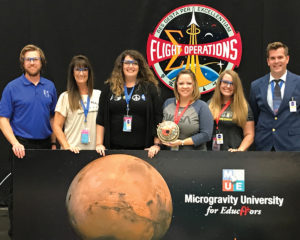 Nancy Parra-Quinlan’s industrial technology students are building rockets in their Kino Junior High School classroom.
Nancy Parra-Quinlan’s industrial technology students are building rockets in their Kino Junior High School classroom.
Engaged and excited, they don’t stop to think about how their teacher gained her expert knowledge. They just know they’re working on cool projects. However, educators, such as Nancy, never stop learning.
Applying real world situations in the classroom
Just as professionals in medicine, architecture and law participate in professional development, so do educators. Mesa Public Schools’ teachers share their passion for learning with students in a variety of ways. This includes honing their skills, while learning new techniques and strategies to provide excellent educational experiences. The sky is the limit for cutting-edge professional development programs.
“We engage students in learning by doing,” said Nancy. “We help them understand the world and guide them toward what they want to do as a career. A multitude of possibilities are available to them beyond doctor, teacher and firefighter.”
In 2015, Nancy attended the Honeywell Educators at Space Camp Academy, at the U.S. Space and Rocket Center, in Huntsville, Ala. She participated in 45 hours of classroom, laboratory and training time focused on science and space exploration. Today, her students are building the same rockets she built during her time at camp.
Team MESA shoots for the stars
A five-teacher team, from Kino Junior High School, Mesa Academy for Advanced Studies and Hale, Mendoza and Porter elementary schools, traveled to Johnson Space Center, in Houston, Texas, to participate in NASA’s Microgravity University for Educators. Their mission was to test a student-derived Satellite Launching Experimental Device on the Precision Air Bearing Floor, while their students watched live through a videoconference at school.
According to Kimberly Merlene, science teacher at Mesa Academy for Advanced Studies, having opportunities to find exciting ways to introduce Science, Technology, Engineering and Mathematics, or STEM, to students in meaningful ways is a priority. “Experiencing it first-hand takes it to another level,” she explained. “Being able to sit in the cockpit of the plane on the way to Houston, chatting with the pilot about the instrument panel, and having the opportunity to experiment in the facility where real astronauts train for their missions was invaluable.”
Expert engineers, astronauts and former teachers in the field introduced lessons, providing tutelage and time, so teachers could create the projects they will introduce to students. Supplies for these projects were shipped to their classrooms. So, now they have everything they need to share their experiences.
“The beauty of science is that students enjoy connecting real-life scenarios with experiments,” said Amber Amaya, fourth-grade and fifth-grade teacher at Porter Elementary School. “Students problem solve and work together as a team, so they may fix issues and make something better, just like they will in the workplace one day.”
For more information about all Mesa Public Schools, please visit mpsaz.org.

